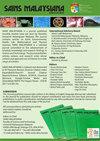17 Years of Coastline Changes Observation in the Northern Part of Rupat Island Using Landsat 7 ETM + Time Series Imagery (2000-2017); A Case Study of the Country’s Border Between Indonesia – Malaysia
IF 0.8
4区 综合性期刊
Q3 MULTIDISCIPLINARY SCIENCES
引用次数: 0
Abstract
Rupat Island is the outermost part of Indonesia which borders Malaysia. This island is part of Bengkalis Regency, Riau Province, located at 02° 4.911'N-101° 27,191'E. This study uses primary data from field observations and secondary data in Landsat 7ETM+ Time Series image data and other supporting data. The descriptive method is carried out in the form of geological interpretation in the field, determination of validation points and then analysis using GIS/visual interpretation to obtain shoreline changes that occurred in the northern part of Rupat Island from the year 2000 to 2017. Additional data used were sea current and pattern and wind direction and speed. Validation points are used to obtain detailed calculations related to this coastline change: Tanjung Api area to Teluk Rhu and Tanjung Lapin get the measurement results experienced the most accretion occurred in 2013 was 167.21 m, and the most abrasion in 2016 was 72.77 m. The biggest change occurred in 2013 when the accretion occurred at 375.5 Ha, and the most abrasion occurred in 2014 at 50.63 Ha. Meanwhile, for shoreline changes, the minimum annual coastline length in 2004 was 19.04 km, and the normal coastline length in 2015 was 28.26 km. The maximum length of the coastline occurred in 2013 was 36.53 km.利用 Landsat 7 ETM + 时间序列影像观测鲁帕特岛北部 17 年海岸线变化(2000-2017 年);印度尼西亚-马来西亚边境案例研究
鲁帕特岛是印度尼西亚的最外围地区,与马来西亚接壤。该岛隶属于廖内省 Bengkalis 行政区,位于北纬 02°4.911'-东经 101°27,191'。本研究使用了来自实地观测的第一手数据和 Landsat 7ETM+ 时间序列图像数据及其他辅助数据中的第二手数据。描述性方法以实地地质解释、确定验证点的形式进行,然后使用地理信息系统/可视解释进行分析,以获得 2000 年至 2017 年期间鲁帕特岛北部发生的海岸线变化。使用的其他数据包括海流和模式以及风向和风速。验证点用于获得与海岸线变化相关的详细计算结果:丹绒阿皮地区到直落鲁和丹绒拉平的测量结果显示,2013 年发生的最大增生为 167.21 米,2016 年发生的最大磨损为 72.77 米;2013 年发生的最大变化为 375.5 公顷的增生,2014 年发生的最大磨损为 50.63 公顷。同时,在海岸线变化方面,2004 年的最小年海岸线长度为 19.04 千米,2015 年的正常海岸线长度为 28.26 千米。最大海岸线长度出现在 2013 年,为 36.53 千米。
本文章由计算机程序翻译,如有差异,请以英文原文为准。
求助全文
约1分钟内获得全文
求助全文
来源期刊

Sains Malaysiana
MULTIDISCIPLINARY SCIENCES-
CiteScore
1.60
自引率
12.50%
发文量
196
审稿时长
3-6 weeks
期刊介绍:
Sains Malaysiana is a refereed journal committed to the advancement of scholarly knowledge and research findings of the several branches of science and technology. It contains articles on Earth Sciences, Health Sciences, Life Sciences, Mathematical Sciences and Physical Sciences. The journal publishes articles, reviews, and research notes whose content and approach are of interest to a wide range of scholars. Sains Malaysiana is published by the UKM Press an its autonomous Editorial Board are drawn from the Faculty of Science and Technology, Universiti Kebangsaan Malaysia. In addition, distinguished scholars from local and foreign universities are appointed to serve as advisory board members and referees.
 求助内容:
求助内容: 应助结果提醒方式:
应助结果提醒方式:


